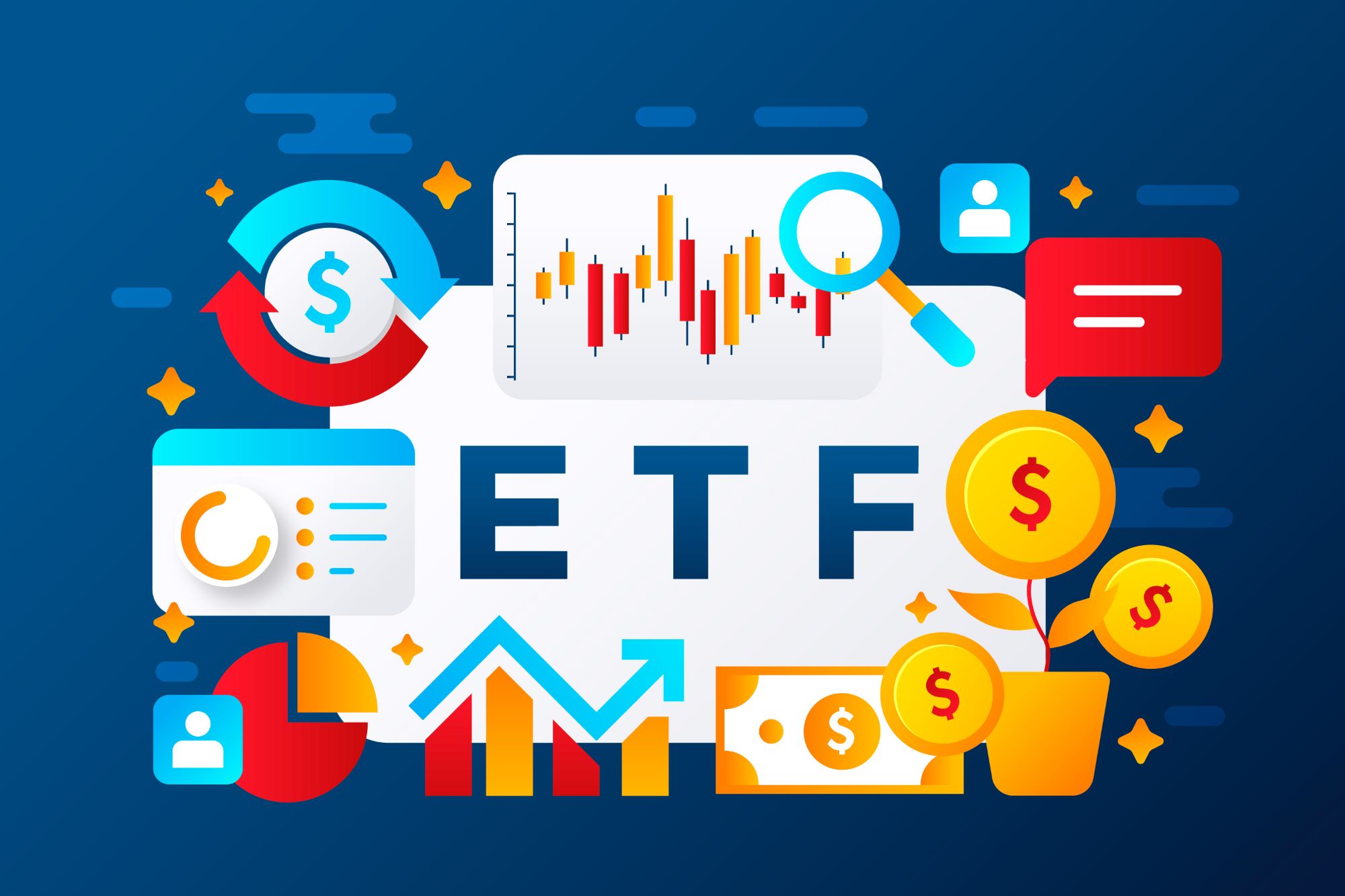Exchange-Traded Funds (ETFs) have gained significant popularity among investors in recent years, offering a convenient and cost-effective way to diversify their portfolios. In this comprehensive guide, we’ll explore everything you need to know about ETFs, from their basic structure to the advantages and disadvantages, as well as how to invest in them effectively.
What are ETFs?
Exchange-Traded Funds (ETFs) represent a unique investment vehicle that combines the features of both mutual funds and individual stocks. These funds are traded on stock exchanges, just like any other stock, providing investors with the opportunity to buy and sell shares throughout the trading day. Unlike traditional mutual funds, which are bought and sold directly through the fund company at the end of the trading day, ETFs offer intraday trading flexibility.
ETFs are designed to track the performance of a specific index, commodity, bond, or a basket of assets. This means that when you invest in an ETF, you are essentially investing in a diversified portfolio of underlying assets. For example, an ETF that tracks the S&P 500 index will hold the same stocks that are included in the index, in the same proportions. This allows investors to gain exposure to a broad market or a specific sector without having to purchase individual stocks.
Moreover, ETFs come in various forms, offering investors a wide range of options to suit their investment objectives and risk tolerance. Whether you’re looking for exposure to domestic or international markets, equities or fixed-income securities, there’s likely an ETF available to meet your needs. Additionally, ETFs often have lower expense ratios compared to actively managed mutual funds, making them an attractive option for cost-conscious investors.
Types of ETFs
When it comes to Exchange-Traded Funds (ETFs), investors have a plethora of options available to suit their investment goals and risk preferences. Let’s delve into the various types of ETFs and the unique opportunities they offer:
| Type of ETF | Description | Example | Key Features |
| Equity ETFs | Equity ETFs primarily invest in stocks, providing exposure to a specific market index, sector, or industry. | SPDR S&P 500 ETF (SPY) | – Diversified exposure to the stock market
– Opportunity for growth – Can track specific sectors or industries |
| Bond ETFs | Bond ETFs invest in fixed-income securities such as government or corporate bonds, offering income and stability. | iShares Core U.S. Aggregate Bond ETF (AGG) | – Steady stream of interest payments
– Potential for capital appreciation – Diversification across bond maturities and credit qualities |
| Commodity ETFs | Commodity ETFs provide access to raw materials like gold, silver, oil, or agricultural products, serving as a hedge against inflation and geopolitical risks. | SPDR Gold Shares (GLD) | – Exposure to commodity markets without physical storage – Potential for portfolio diversification
– Inflation and currency risk hedging |
| Sector ETFs | Sector ETFs focus on specific sectors of the economy, allowing investors to capitalize on growth trends or defensive characteristics. | Technology Select Sector SPDR Fund (XLK) | – Targeted exposure to specific industries
– Opportunity to capitalize on sector trends – Diversification across companies within the sector |
| International ETFs | International ETFs invest in stocks or bonds from countries outside the investor’s home country, providing global diversification and exposure to emerging markets. | Vanguard FTSE Developed Markets ETF (VEA) | – Access to global markets and economies
– Opportunity for growth in emerging markets – Currency risk hedging |
In summary, Exchange-Traded Funds (ETFs) come in various shapes and sizes, offering investors a wide range of options to build diversified portfolios and achieve their financial goals.
Whether you’re seeking growth, income, or diversification, there’s likely an ETF available to meet your needs. By understanding the different types of ETFs and their unique characteristics, investors can make informed decisions and construct well-balanced investment portfolios.
Advantages of ETFs
When compared to traditional mutual funds or individual stocks, ETFs offer several advantages for investors:
- Diversification: ETFs provide investors with instant diversification by holding a basket of assets within a single fund.
- Low costs: ETFs typically have lower expense ratios compared to mutual funds, making them a cost-effective investment option.
- Liquidity: Since ETFs are traded on stock exchanges, they offer high liquidity, allowing investors to buy and sell shares throughout the trading day at market prices.
- Transparency: ETFs disclose their holdings on a daily basis, providing investors with transparency into the underlying assets held by the fund.
In summary, ETFs offer investors a convenient and cost-effective way to diversify their portfolios and gain exposure to various asset classes and investment strategies.
Disadvantages of ETFs
However, despite their numerous benefits, ETFs also come with some drawbacks that investors should consider:
- Tracking error: ETFs may not perfectly track the performance of their underlying index, leading to underperformance compared to the index.
- Trading commissions: Investors may incur trading commissions when buying and selling ETF shares, which can erode returns, especially for frequent traders.
- Lack of active management: Most ETFs are passively managed, meaning they simply track an index and do not have a team of portfolio managers actively making investment decisions.
Despite these drawbacks, ETFs remain a popular choice for investors seeking diversification, low costs, and transparency in their investment portfolios.
How to Invest in ETFs
When selecting an ETF, investors should conduct thorough research to identify funds that align with their investment objectives, risk tolerance, and time horizon. Factors to consider include the fund’s investment strategy, underlying assets, expense ratio, historical performance, and tracking error. By carefully evaluating these factors, investors can make informed decisions and choose ETFs that suit their individual needs and preferences.
To invest in ETFs, investors first need to open a brokerage account with a reputable brokerage firm. This can typically be done online by completing an application form and providing personal information, such as name, address, and Social Security number. Once the account is opened and funded, investors gain access to the brokerage’s trading platform, where they can buy and sell ETF shares.
Buying and selling ETF shares is similar to trading individual stocks and can be done through the brokerage’s trading platform. Investors can search for the desired ETF using its ticker symbol or name and place orders to buy or sell shares at the prevailing market price. Additionally, investors can use various order types, such as market orders, limit orders, or stop-loss orders, to execute trades according to their specific preferences and investment strategies. It’s essential for investors to monitor their ETF holdings regularly and stay informed about market developments to make timely investment decisions and adjust their portfolios as needed.
By following these steps, investors can effectively invest in ETFs and build diversified portfolios tailored to their financial goals and risk preferences. With the convenience and flexibility offered by ETFs, investors can take advantage of market opportunities and achieve long-term investment success.
Tax Considerations for ETF Investors
Capital gains taxes
When investors sell their ETF shares at a profit, they may be subject to capital gains taxes. Capital gains are typically classified as either short-term or long-term, depending on how long the investor held the ETF shares before selling them.
Short-term capital gains are taxed at the investor’s ordinary income tax rate, which can be higher than the rate for long-term capital gains. On the other hand, long-term capital gains are taxed at a lower rate, typically ranging from 0% to 20%, depending on the investor’s income level and filing status.
To minimize the impact of capital gains taxes, investors can employ tax-efficient strategies such as tax-loss harvesting or holding onto ETF shares for the long term. Additionally, investing in ETFs that have low turnover rates can help reduce the occurrence of capital gains distributions, which can trigger taxable events for investors.
Dividend taxes
ETF investors may also be required to pay taxes on any dividends received from the underlying assets held by the fund. Dividends distributed by ETFs are typically classified as qualified or non-qualified dividends, depending on the source of the income and how long the ETF shares were held. Qualified dividends are taxed at the preferential long-term capital gains tax rate, while non-qualified dividends are taxed at the investor’s ordinary income tax rate.
Investors should be aware of the tax treatment of dividends from ETFs and consider the tax implications when making investment decisions. Additionally, investors can explore tax-efficient ETFs that focus on minimizing taxable distributions by employing strategies such as investing in stocks that do not pay dividends or using swap contracts to replicate index returns without generating dividend income.
In summary, understanding the tax considerations associated with investing in ETFs is essential for maximizing after-tax returns and optimizing overall investment performance. By being mindful of capital gains taxes and dividend taxes, investors can make informed decisions and implement tax-efficient strategies to enhance their investment outcomes.




